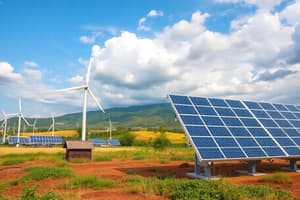Podcast
Questions and Answers
What unit is used to measure energy?
What unit is used to measure energy?
- Joules (correct)
- Pascals
- Watts
- Newtons
What describes the energy transformation in photosynthesis?
What describes the energy transformation in photosynthesis?
- Radiant energy to chemical energy (correct)
- Chemical energy to radiant energy
- Nuclear energy to chemical energy
- Kinetic energy to potential energy
Which of the following types of potential energy is associated with an object's height?
Which of the following types of potential energy is associated with an object's height?
- Mechanical potential energy
- Gravitational potential energy (correct)
- Chemical potential energy
- Elastic potential energy
How is kinetic energy calculated?
How is kinetic energy calculated?
What is true about mechanical energy?
What is true about mechanical energy?
What is the primary source of energy for the Sun?
What is the primary source of energy for the Sun?
Which process of heat transfer involves the direct contact between materials?
Which process of heat transfer involves the direct contact between materials?
Which factor increases the amount of friction between two surfaces?
Which factor increases the amount of friction between two surfaces?
Flashcards
Energy
Energy
The ability to cause change. It is something that makes things happen.
Potential Energy
Potential Energy
Stored energy that an object has due to its position or state. It is waiting to be released.
Kinetic Energy
Kinetic Energy
Energy of motion. It is the energy possessed by an object due to its movement.
Mechanical Energy
Mechanical Energy
Signup and view all the flashcards
Work
Work
Signup and view all the flashcards
Friction
Friction
Signup and view all the flashcards
Law of Conservation of Energy
Law of Conservation of Energy
Signup and view all the flashcards
Heat Transfer
Heat Transfer
Signup and view all the flashcards
Study Notes
Energy and Energy Transfer
- Energy: The ability to cause change. Cannot be seen, but its effects can be felt.
- Electric Energy: Energy carried by currents.
- Potential Energy: Stored energy within an object.
- Types: Gravitational, elastic, chemical.
- Kinetic Energy: Energy due to motion.
- Nuclear Energy: Stored within an atom's nucleus.
- Radiant Energy: Energy that travels as waves.
- Mechanical Energy: Sum of potential and kinetic energy. Always equals 100%.
- Unit of Energy: Joules (J).
- Calculating Potential Energy: Mass * Gravity * Height
- Calculating Kinetic Energy: 0.5 * Mass * Velocity²
- Thermal Energy Transfer: Occurs through radiation, conduction, and convection. Heat flows from hot to cold until uniform.
- Relationship between Potential and Kinetic Energy: Opposites; one transforms into the other.
- Food Energy: Chemical energy.
- Photosynthesis Transformation: Radiant energy to chemical energy.
- ATP Energy: Energy cells receive from food.
- Law of Conservation of Energy: Energy cannot be created or destroyed; it can only be transformed.
- Sun's Energy Source: Fusion of hydrogen atoms into helium.
- Comparing Kinetic Energy: Comparing the masses and velocities of objects. If one object is greater times the other then the other object has a greater kinetic energy.
Motion and Force
- Motion: Change in an object's position.
- Force: Push or pull.
- Work: Application of force causing movement in that direction.
- Work Formula: Work = Force * Distance
- Unit of Work: Joules (J).
Friction
- Friction: Force resisting two surfaces sliding past each other.
- Friction Factors: Rougher surfaces have more friction.
- Reducing Friction: Using lubricants like oil or grease.
Studying That Suits You
Use AI to generate personalized quizzes and flashcards to suit your learning preferences.




